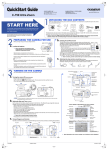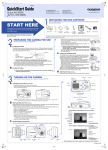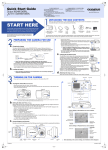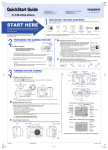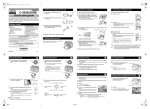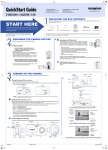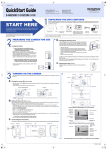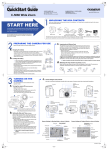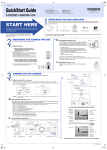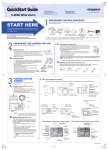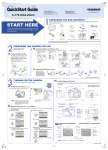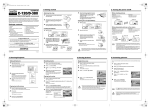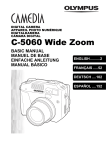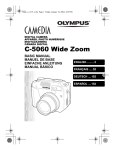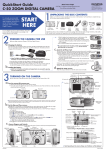Download Olympus C-5000 Quick Start Guide
Transcript
x193_qsge_pquick_6.fm Page 1 Wednesday, July 9, 2003 9:09 PM QuickStart Guide OLYMPUS AMERICA INC. Two Corporate Center Drive, Melville, NY 11747-3157, U.S.A. http://support.olympusamerica.com/ C-5000Zoom OLYMPUS CO. (EUROPA) GMBH. Wendenstrasse 14-18, 20097 Hamburg, Germany http://www.olympus-europa.com/ http://www.olympus.com/ UNPACKING THE BOX CONTENTS Gather your Digital camera and the parts as shown in the illustration. You’ll need these to complete the steps for the camera set-up procedures that follow. START HERE It is strongly recommended that you follow these step-by-step numbered instructions to set up and quickly begin using your new Digital camera. Digital camera Strap Lens cap & string Lithium ion battery CAMEDIA Master CD-ROM USB cable (gray color) xD-Picture Card The following items are also included in the Digital camera package: Basic Manual, video cable, RM-2 remote control, battery charger (LI10C), warranty card, registration card (not provided in some areas), and safety precautions booklet. For more detailed instructions on advanced features, please refer to the printed Basic Manual included in your package, or the Reference Manual on the CD-ROM. PREPARING THE CAMERA FOR USE 4) Face the card the correct way and insert it into 3) Insert the battery, making sure it is correctly the card slot. orientated. Then use the battery lock to lock • To remove the card, push the card all the the battery in place. way in to unlock it. As it emerges, hold the • To remove the battery, slide the battery lock in the card straight and pull it out. direction of the arrow. As the battery emerges, hold it straight and pull it out completely. Index area side Before you begin using your Olympus Digital camera… a. Charging the battery Groove section Battery lock The battery is not fully charged when purchased. Before use, be sure to charge the battery with the specified provided charger (LI10C). Make sure that the + and - terminals of the battery shown in the illustration on the right are correctly oriented when loading the battery into the charger. 5) Close the battery/card cover in direction C then slide it in direction D. C D b. Inserting the battery xD-Picture card 1) Make sure the camera is turned off. c. Attaching the strap and lens cap string 2) Slide the battery/card cover in the direction of A, then lift in the direction of B. (OPTIONAL) Attach the lens cap string and strap to the strap eyelets on each side of the camera as illustrated. Attaching the strap to the camera makes it easier to handle. B A TURNING ON THE CAMERA Macro/Spot button Protect button The camera Mode dial is used to select the various operation modes. a. Turning the camera ON Hot shoe Mode dial Orange lamp Flash mode button Erase button (SHOOTING MODE) • Remove the lens cap. • Set the mode dial to h. Turn the power switch to the ON position. The lens extends and the monitor turns on. • To turn the camera off, turn the power switch to the OFF position. Viewfinder Card access lamp AEL/Custom button Rotation button Green lamp Monitor Arrow pad OK/Menu button Power Switch Mode dial Battery/Card cover Power Switch TIP :To maximize battery life, the Digital camera features a power saving mode in which the camera enters a sleep mode after approximately three (3) minutes of non-use. b. Setting the Date and Time Tripod socket (OPTIONAL) Set the date and time before using the camera for the first time. This affects the way image file names are created, and will conveniently include this information with each picture. • • • • • • • Set the mode dial to P and turn the power switch to the ON position. Press e. The top menu is displayed. Press d on the arrow pad to select MODE MENU. Press ac to select the SETUP tab, then press d. Press ac to select X, then press d. Use ac to select the date format. Adjust the date and time in the appropriate fields by using d to select the field, and ac to set the proper value. Repeat this step until all date/time fields have been set. Note: Time is entered using the 24-hour format. • Press e twice to set the date and time and exit the menu. c. Camera Diagram and Controls Strap eyelet Zoom lever Shooting modes USB connector Flash VIDEO OUT jack Exposure compensation Exposure differential Shutter speed Aperture value AE lock AE memory Spot metering Battery check Green lamp Flash stand-by Macro mode Noise reduction Flash mode ISO White balance White balance compensation Saturation Sharpness Flash intensity control Contrast Drive Self-timer/Remote Control Record mode Resolution Now take a moment to familiarize yourself with the key areas of camera controls by reviewing the illustrations. Shutter button Camera Settings in Shooting Mode as shown in Monitor Memory gauge AF target mark Number of storable still pictures Camera Settings in Playback Mode as shown in Monitor Print reservation, Number of prints Battery check Protect Record mode Resolution Aperture value Shutter speed Exposure compensation White balance ISO Date and time File number, Frame number Playing time/total recording time Note: Depending on the camera settings, not all indicators will be displayed. Self-timer/Remote control lamp Lens DC-IN jack Remote control receiver VT575301 1AG6P1P1559-- Printed in Japan x193_qsge_pquick_6.fm Page 2 Wednesday, July 9, 2003 9:09 PM TAKING PICTURES The Digital camera confirms the focus and exposure are properly set when the green lamp lights steadily. The # indicator informs you that the flash is recommended and/ or recharging (when blinking); or ready to fire (when steady). There are two ways to compose your subject: using the monitor or with the viewfinder. Depending upon the shooting situation, there may be advantages to each method. Please refer to the printed Basic Manual for more information. a. Taking a Picture • Set the mode dial to h and turn the power switch to the ON position. The monitor turns on. • Press f to turn the monitor off when the monitor is on. • Compose your subject in the viewfinder or on the monitor. No indication ! • Press the shutter button completely to take the picture. A short beep confirms your picture has been taken. # This Digital camera features a zoom lens, allowing you to get closer to action, or capture wide-angle shots and get everything into the picture. $ SQ1 1600 1200 Push to Zoom out Shutter button Pull to Zoom in • Push the zoom lever toward W to zoom out and get everything into the picture. • Pull the zoom lever toward T to choose telephoto shooting and get closer to the action. • Press the shutter button halfway. c. Flash Modes Press the # button to cycle through the flash modes: b. Erasing Pictures With a Digital camera, you can easily view the photos you want—and delete the ones you don’t. a. Viewing Pictures There are two ways to access the Playback mode: • Set the mode dial to q and press the power switch. OR • If the camera is in the shooting mode with the lens barrel extended, press the QUICK VIEW button. The last picture taken appears in the monitor. Use bdac to scroll through all the images saved on your xD-Picture Card. When you are finished reviewing your pictures: • Turn the power switch to the OFF position. OR • To return to the shooting mode, press the QUICK VIEW button again. The beauty of digital photography is your ability to keep the photos you want, delete the rest, and reuse empty memory space to take new pictures. This Digital camera offers two ways to permanently erase unwanted digital photos: Single-Frame Erase: Deletes only the picture currently displayed in the monitor. Once erased, pictures cannot be restored. • Set the mode dial to q and turn the power switch to the ON position. • Use the arrow pad to display the picture you want to erase. • Press S. • Press ac to select YES, then press e. Red-eye Reduces incidence of red-eye by emitting pre-flashes Reduction Flash to shrink pupil size before firing the main flash. The strobe effect is normal operation for this mode. Fill-in Flash The flash always fires with every picture. Flash Off Turns the flash off for times when flash photography is prohibited or not desired. The flash never fires. Your digital camera can handle xD-Picture Card from 16 MB to 256 MB. The number of storable pictures depends on the image quality selected. See the Reference Manual for complete descriptions of each recording mode and the storable frame capacity for the various resolution modes and xD-Picture Card capacities. TIP :To find out how many frames you have left, look for the number in the lower right corner. Remember, you can always delete unwanted pictures to make room for more. (See Step 5.) All-Frame Erase: Deletes all pictures on the xD-Picture Card in one operation, except for pictures you have protected. Once erased, pictures cannot be restored. • Set the mode dial to q and turn the power switch to the ON position. • Press e, then press d to select MODE MENU. • Use ac to select the CARD tab, then press d twice to access the CARD SETUP screen. • R ALL ERASE should be highlighted. Press e. • As a safeguard, the Digital camera will ask you to select YES or NO to confirm erasing, as this process permanently deletes all unprotected pictures. Select YES and press e. TIP :Images can also be erased while in the “QUICK VIEW” mode described in step 5a. This makes it easy to quickly erase a picture that you just took. CONNECTING THE CAMERA TO A COMPUTER Windows 98 users must install the “USB Driver for Windows 98” software before connecting the Digital camera to the computer. Refer to the Software Installation Guide for complete information. TIP :Olympus recommends using the optional AC adapter to ensure a consistent power supply when downloading images. Make sure that the camera is turned off before connecting it to your computer. The camera automatically decides if the flash is needed. d. Number of Storable Pictures This Digital camera features multiple flash modes. Please note that not all flash modes are available depending on the shooting mode selected. VIEWING AND ERASING PICTURES Auto-flash Description With the shutter button depressed halfway, the flash is ready to fire when the # indicator in the monitor or the orange lamp next to the viewfinder lights. When the # indicator or the orange lamp is blinking, the flash is charging. Green lamp Icons representing camera settings appear on the monitor, telling you important information such as the Flash and record modes, battery life, and the number of frames remaining. Flash Mode #SLOW1, Slow Adjusts the flash for special situations requiring slow #SLOW2, Synchronization shutter speeds. HSLOW b. Zooming F2.8 Flash stand-by/Flash charge Icon • Set the mode dial to q and press the power switch. The camera starts communicating with the PC. Olympus makes it simple to connect the Digital camera to your computer. • Turn the camera off. • Plug the supplied USB cable into the USB connector on your camera and computer as illustrated at right. INSTALLING THE CAMERA SOFTWARE You've now mastered the basic functionality of your new Olympus Digital Camera! You are now ready to begin exploring the possibilities that digital photography brings to your computer. Activities such as photo editing, printing, and much more are only steps away! About the Olympus CAMEDIA Master CD-ROM Your Olympus Digital Camera comes bundled with a suite of software and documentation. The CD includes: • CAMEDIA Master: To download pictures from the camera, view, organize, retouch and print your digital photos and movies. • USB Driver for Windows 98: This utility must be installed to allow the camera to communicate with your computer if it uses the Microsoft Windows 98 operating system. • Olympus Digital Camera Reference Manual: A complete reference guide in digital form, saved on the CD in PDF format. You are now ready to install the computer software. • Open the CAMEDIA Master CD-ROM package and locate the Software Installation Guide in the language you wish to use. • Continue to follow the step-by-step instructions for installing the software, and enjoy your new digital photo processing capabilities! Additional Camera Features This Digital camera offers a host of advanced features to expand your creativity. Here’s just a small sampling. See the Basic Manual for details on these capabilities, and more! • Advanced photographic control: Aperture Priority, Shutter Priority, and full Manual modes are available to give you complete control of your photography. • 6 Scene Program Shooting Modes: This camera has 6 shooting modes to choose from depending on the shooting conditions and the effect you want to achieve. • Macro Mode and Super Macro Mode: For taking extremely tight close-up pictures. • Sequential Shooting: Take a rapid succession of still pictures. • Still Picture Editing: Edit still pictures and store them as new pictures. • Movie Recording: Yes, this Digital camera records movies! • Two-in-one Pictures: Combine two separate images taken in succession and store them as a single picture. • Close-up Playback: Enlarge the pictures in the monitor to check details of the selected image. • Index Display: View several thumbnail pictures on the monitor at once. • Protecting Pictures: Prevents you from accidentally erasing photos. • Video Playback: View your pictures and movies on a television monitor. • Panorama Shooting: Connect overlapping images into a single picture using the panorama mode and Olympus CAMEDIA Master software. TIP :Remember to complete and return your Registration Card (not provided in some areas), and keep all camera documentation handy. Technical Support (USA) 1-888-553-4448 (Toll-free) 8:00 AM - 10:00 PM ET Monday - Friday European Technical Customer Support 00800-67 10 83 00 (Toll-free) + 49 180 5 - 67 10 83 or +49 40 - 23 77 38 99 (Charged) 9:00 AM - 6:00 PM MET Monday - Friday


